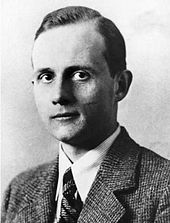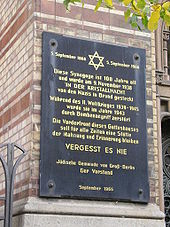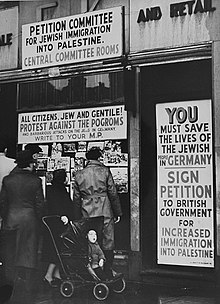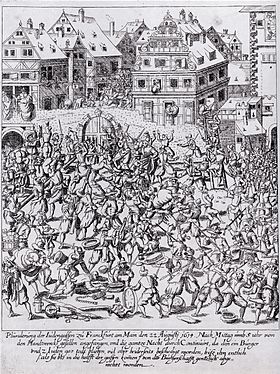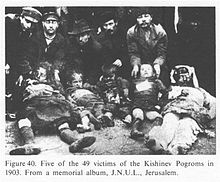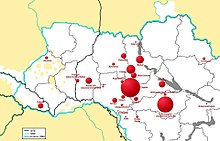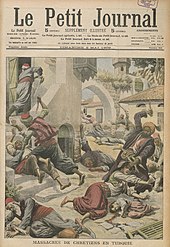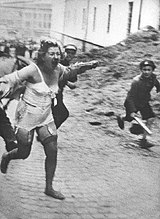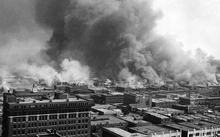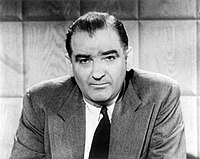| Kristallnacht | |
|---|---|

Destroyed synagogue in Aachen
| |
| Location | Nazi Germany (then including Austria and the Sudetenland) Free City of Danzig |
| Date | 9–10 November 1938 |
| Target | Jews |
Attack type
| Pogrom, looting, arson, mass arrests |
| Deaths | 91+ |
| Perpetrators | Sturmabteilung (SA) stormtroopers, German civilians |
| Motive | Antisemitism |
Kristallnacht (German pronunciation: [kʁɪsˈtalnaχt] or the Night of Broken Glass, also called the November Pogrom(s), was a pogrom against Jews carried out by SA paramilitary forces and civilians throughout Nazi Germany on 9–10 November 1938. The German authorities looked on without intervening. The name Kristallnacht ("Crystal Night") comes from the shards of broken glass that littered the streets after the windows of Jewish-owned stores, buildings and synagogues were smashed. The pretext for the attacks was the assassination of the German diplomat Ernst vom Rath by Herschel Grynszpan, a 17-year-old German-born Polish Jew living in Paris.
Jewish homes, hospitals and schools were ransacked as attackers demolished buildings with sledgehammers. Rioters destroyed 267 synagogues throughout Germany, Austria and the Sudetenland. Over 7,000 Jewish businesses were damaged or destroyed, and 30,000 Jewish men were arrested and incarcerated in concentration camps. British historian Martin Gilbert wrote that no event in the history of German Jews between 1933 and 1945 was so widely reported as it was happening, and the accounts from foreign journalists working in Germany sent shockwaves around the world. The Times of London observed on 11 November 1938: "No foreign propagandist bent upon blackening Germany before the world could outdo the tale of burnings and beatings, of blackguardly assaults on defenceless and innocent people, which disgraced that country yesterday."
Estimates of fatalities caused by the attacks have varied. Early reports estimated that 91 Jews had been murdered. Modern analysis of German scholarly sources puts the figure much higher; when deaths from post-arrest maltreatment and subsequent suicides are included, the death toll reaches the hundreds, with Richard J. Evans estimating 638 deaths by suicide. Historians view Kristallnacht as a prelude to the Final Solution and the murder of six million Jews during the Holocaust.
Background
Early Nazi persecutions
In
the 1920s, most German Jews were fully integrated into German society
as German citizens. They served in the German army and navy and
contributed to every field of German business, science and culture. Conditions for German Jews began to change after the appointment of Adolf Hitler (the Austrian-born leader of the National Socialist German Workers' Party) as Chancellor of Germany on 30 January 1933, and the Enabling Act (implemented 23 March 1933) which enabled the assumption of power by Hitler after the Reichstag fire of 27 February 1933. From its inception, Hitler's régime moved quickly to introduce anti-Jewish policies. Nazi propaganda
alienated 500,000 Jews in Germany, who accounted for only 0.86% of the
overall population, and framed them as an enemy responsible for
Germany's defeat in the First World War and for its subsequent economic disasters, such as the 1920s hyperinflation and Wall Street Crash Great Depression. Beginning in 1933, the German government enacted a series of anti-Jewish laws restricting the rights of German Jews to earn a living, to enjoy full citizenship and to gain education, including the Law for the Restoration of the Professional Civil Service of 7 April 1933, which forbade Jews to work in the civil service. The subsequent 1935 Nuremberg Laws stripped German Jews of their citizenship and prohibited Jews from marrying non-Jewish Germans.
These laws resulted in the exclusion and alienation of Jews from German social and political life. Many sought asylum abroad; hundreds of thousands emigrated, but as Chaim Weizmann
wrote in 1936, "The world seemed to be divided into two parts—those
places where the Jews could not live and those where they could not
enter." The international Évian Conference on 6 July 1938 addressed the issue of Jewish and Gypsy immigration to other countries. By the time the conference took place, more than 250,000 Jews had fled Germany and Austria, which had been annexed by Germany
in March 1938; more than 300,000 German and Austrian Jews continued to
seek refuge and asylum from oppression. As the number of Jews and
Gypsies wanting to leave increased, the restrictions against them grew,
with many countries tightening their rules for admission. By 1938,
Germany "had entered a new radical phase in anti-Semitic activity".
Some historians believe that the Nazi government had been contemplating
a planned outbreak of violence against the Jews and were waiting for an
appropriate provocation; there is evidence of this planning dating back
to 1937. In a 1997 interview, the German historian Hans Mommsen claimed that a major motive for the pogrom was the desire of the Gauleiters of the NSDAP to seize Jewish property and businesses. Mommsen stated:
The need for money by the party organization stemmed from the fact that Franz Xaver Schwarz, the party treasurer, kept the local and regional organizations of the party short of money. In the fall of 1938, the increased pressure on Jewish property nourished the party's ambition, especially since Hjalmar Schacht had been ousted as Reich minister for economics. This, however, was only one aspect of the origin of the November 1938 pogrom. The Polish government threatened to extradite all Jews who were Polish citizens but would stay in Germany, thus creating a burden of responsibility on the German side. The immediate reaction by the Gestapo was to push the Polish Jews—16,000 persons—over the borderline, but this measure failed due to the stubbornness of the Polish customs officers. The loss of prestige as a result of this abortive operation called for some sort of compensation. Thus, the overreaction to Herschel Grynszpan's attempt against the diplomat Ernst vom Rath came into being and led to the November pogrom. The background of the pogrom was signified by a sharp cleavage of interests between the different agencies of party and state. While the Nazi party was interested in improving its financial strength on the regional and local level by taking over Jewish property, Hermann Göring, in charge of the Four-Year Plan, hoped to acquire access to foreign currency in order to pay for the import of urgently-needed raw material. Heydrich and Himmler were interested in fostering Jewish emigration.
The Zionist leadership in the British Mandate of Palestine
wrote in February 1938 that according to "a very reliable private
source—one which can be traced back to the highest echelons of the SS
leadership", there was "an intention to carry out a genuine and dramatic
pogrom in Germany on a large scale in the near future".
Expulsion of Polish Jews in Germany
Polish Jews expelled from Germany in late October 1938
In August 1938, German authorities announced that residence permits
for foreigners were being canceled and would have to be renewed. This included German-born Jews of foreign citizenship. Poland stated that it would renounce citizenship rights of Polish Jews living abroad for at least five years after the end of October, effectively making them stateless. In the so-called "Polenaktion", more than 12,000 Polish Jews, among them the philosopher and theologian Rabbi Abraham Joshua Heschel, and future literary critic Marcel Reich-Ranicki
were expelled from Germany on 28 October 1938, on Hitler's orders. They
were ordered to leave their homes in a single night and were allowed
only one suitcase per person to carry their belongings. As the Jews were
taken away, their remaining possessions were seized as loot both by
Nazi authorities and by neighbors.
The deportees were taken from their homes to railway stations and
were put on trains to the Polish border, where Polish border guards
sent them back into Germany. This stalemate continued for days in the
pouring rain, with the Jews marching without food or shelter between the
borders. Four thousand were granted entry into Poland,
but the remaining 8,000 were forced to stay at the border. They waited
there in harsh conditions to be allowed to enter Poland. A British
newspaper told its readers that hundreds "are reported to be lying
about, penniless and deserted, in little villages along the frontier
near where they had been driven out by the Gestapo and left." Conditions in the refugee camps
"were so bad that some actually tried to escape back into Germany and
were shot", recalled a British woman who was sent to help those who had
been expelled.
Shooting of vom Rath
Herschel Grynszpan, 7 November 1938
Among those expelled was the family of Sendel and Riva Grynszpan,
Polish Jews who had emigrated to Germany in 1911 and settled in Hanover, Germany. At the trial of Adolf Eichmann
in 1961, Sendel Grynszpan recounted the events of their deportation
from Hanover on the night of 27 October 1938: "Then they took us in
police trucks, in prisoners' lorries, about 20 men in each truck, and
they took us to the railway station. The streets were full of people
shouting: 'Juden Raus! Auf Nach Palästina!'" ("Jews out, out to Palestine!"). Their seventeen-year-old son Herschel was living in Paris with an uncle.
Herschel received a postcard from his family from the Polish border,
describing the family's expulsion: "No one told us what was up, but we
realized this was going to be the end ... We haven't a penny. Could you
send us something?" He received the postcard on 3 November 1938.
On the morning of Monday, 7 November 1938, he purchased a
revolver and a box of bullets, then went to the German embassy and asked
to see an embassy official. After he was taken to the office of Ernst vom Rath,
Grynszpan fired five bullets at Vom Rath, two of which hit him in the
abdomen. Vom Rath was a professional diplomat with the Foreign Office
who expressed anti-Nazi sympathies, largely based on the Nazis'
treatment of the Jews, and was under Gestapo investigation for being
politically unreliable.
Grynszpan made no attempt to escape the French police and freely
confessed to the shooting. In his pocket, he carried a postcard to his
parents with the message, "May God forgive me ... I must protest so that
the whole world hears my protest, and that I will do." It is widely
assumed that the assassination was politically motivated, but historian Hans-Jürgen Döscher
says the shooting may have been the result of a homosexual love affair
gone wrong. Grynszpan and vom Rath had become intimate after they met in
Le Boeuf sur le Toit, which was a popular meeting place for gay men at the time.
The next day, the German government retaliated, barring Jewish
children from German state elementary schools, indefinitely suspending
Jewish cultural activities, and putting a halt to the publication of
Jewish newspapers and magazines, including the three national German
Jewish newspapers. A newspaper in Britain described the last move, which
cut off the Jewish populace from their leaders, as "intended to disrupt
the Jewish community and rob it of the last frail ties which hold it
together." Their rights as citizens had been stripped.
One of the first legal measures issued was an order by Heinrich
Himmler, commander of all German police, forbidding Jews to possess any
weapons whatsoever and imposing a penalty of twenty years' confinement
in a concentration camp upon every Jew found in possession of a weapon
hereafter.
Pogrom
Death of vom Rath
Telegram sent by Reinhard Heydrich, 10 November 1938
Ernst Vom Rath died of his wounds on 9 November 1938. Word of his
death reached Hitler that evening while he was with several key members
of the Nazi party at a dinner commemorating the 1923 Beer Hall Putsch. After intense discussions, Hitler left the assembly abruptly without giving his usual address. Propaganda Minister Joseph Goebbels
delivered the speech, in his place, and said that "the Führer has
decided that... demonstrations should not be prepared or organized by
the party, but insofar as they erupt spontaneously, they are not to be
hampered." The chief party judge Walter Buch later stated that the message was clear; with these words, Goebbels had commanded the party leaders to organize a pogrom.
Some leading party officials disagreed with Goebbels' actions, fearing the diplomatic crisis it would provoke. Heinrich Himmler
wrote, "I suppose that it is Goebbels's megalomania...and stupidity
which is responsible for starting this operation now, in a particularly
difficult diplomatic situation." The Israeli historian Saul Friedländer believes that Goebbels had personal reasons for wanting to bring about Kristallnacht. Goebbels had recently suffered humiliation for the ineffectiveness of his propaganda campaign during the Sudeten crisis, and was in some disgrace over an affair with a Czech actress, Lída Baarová. Goebbels needed a chance to improve his standing in the eyes of Hitler. At 1:20 am on 10 November 1938, Reinhard Heydrich sent an urgent secret telegram to the Sicherheitspolizei (Security Police; SiPo) and the Sturmabteilung
(SA), containing instructions regarding the riots. This included
guidelines for the protection of foreigners and non-Jewish businesses
and property. Police were instructed not to interfere with the riots
unless the guidelines were violated. Police were also instructed to
seize Jewish archives from synagogues and community offices, and to
arrest and detain "healthy male Jews, who are not too old", for eventual
transfer to (labor) concentration camps.
Riots
Kristallnacht, shop damage in Magdeburg
Müller, in a message to SA and SS commanders, stated the "most extreme measures" were to be taken against Jewish people. The SA and Hitler Youth shattered the windows of about 7,500 Jewish stores and businesses, hence the appellation Kristallnacht (Crystal Night), and looted their goods.
Jewish homes were ransacked all throughout Germany. Although violence
against Jews had not been explicitly condoned by the authorities, there
were cases of Jews being beaten or assaulted. Following the violence,
police departments recorded a large number of suicides and rapes.
The rioters destroyed 267 synagogues throughout Germany, Austria, and the Sudetenland. Over 1400 synagogues and prayer rooms, many Jewish cemeteries, more than 7,000 Jewish shops, and 29 department stores were damaged, and in many cases destroyed. More than 30,000 Jewish men were arrested and imprisoned in Nazi concentration camps; primarily Dachau, Buchenwald, and Sachsenhausen.
The synagogues, some centuries old, were also victims of
considerable violence and vandalism, with the tactics the Stormtroops
practiced on these and other sacred sites described as "approaching the
ghoulish" by the United States Consul in Leipzig. Tombstones were
uprooted and graves violated. Fires were lit, and prayer books, scrolls,
artwork and philosophy texts were thrown upon them, and precious
buildings were either burned or smashed until unrecognizable. Eric Lucas
recalls the destruction of the synagogue that a tiny Jewish community
had constructed in a small village only twelve years earlier:
It did not take long before the first heavy grey stones came tumbling down, and the children of the village amused themselves as they flung stones into the many colored windows. When the first rays of a cold and pale November sun penetrated the heavy dark clouds, the little synagogue was but a heap of stone, broken glass and smashed-up woodwork.
After this, the Jewish community was fined 1 billion Reichsmarks
(equivalent to 4 billion 2009 €). In addition, it cost 40 million marks
to repair the windows.
The Daily Telegraph correspondent, Hugh Greene, wrote of events in Berlin:
Mob law ruled in Berlin throughout the afternoon and evening and hordes of hooligans indulged in an orgy of destruction. I have seen several anti-Jewish outbreaks in Germany during the last five years, but never anything as nauseating as this. Racial hatred and hysteria seemed to have taken complete hold of otherwise decent people. I saw fashionably dressed women clapping their hands and screaming with glee, while respectable middle-class mothers held up their babies to see the "fun".
Jews are being forced to walk with the star of David during the Kristallnacht
Many Berliners were however deeply ashamed of the pogrom, and some
took great personal risks to offer help. The son of a US consular
official heard the janitor of his block cry: "They must have emptied the
insane asylums and penitentiaries to find people who'd do things like
that!"
Tucson News
TV channel briefly reported on a 2008 remembrance meeting at a local
Jewish congregation. According to eyewitness Esther Harris: "They ripped
up the belongings, the books, knocked over furniture, shouted
obscenities". Historian Gerhard Weinberg is quoted as saying:
Houses of worship burned down, vandalized, in every community in the country where people either participate or watch.
Aftermath
A ruined synagogue in Munich after Kristallnacht
A ruined synagogue in Eisenach after Kristallnacht
Former German Kaiser Wilhelm II commented "For the first time, I am ashamed to be German."
Göring, who was in favor of expropriating the Jews rather than
destroying Jewish property as had happened in the pogrom, complained
directly to Sicherheitspolizei Chief Heydrich immediately after
the events: "I'd rather you had done in two-hundred Jews than destroy so
many valuable assets!" ("Mir wäre lieber gewesen, ihr hättet 200 Juden erschlagen und hättet nicht solche Werte vernichtet!").
Göring met with other members of the Nazi leadership on 12 November to
plan the next steps after the riot, setting the stage for formal
government action. In the transcript of the meeting, Göring said,
I have received a letter written on the Führer's orders requesting that the Jewish question be now, once and for all, coordinated and solved one way or another... I should not want to leave any doubt, gentlemen, as to the aim of today's meeting. We have not come together merely to talk again, but to make decisions, and I implore competent agencies to take all measures for the elimination of the Jew from the German economy, and to submit them to me.
The persecution and economic damage inflicted upon German Jews
continued after the pogrom, even as their places of business were
ransacked. They were forced to pay Judenvermögensabgabe,
a collective fine of one billion marks for the murder of vom Rath
(equal to roughly $US 5.5 billion in today's currency), which was levied
by the compulsory acquisition of 20% of all Jewish property by the
state. Six million Reichsmarks of insurance payments for property damage
due to the Jewish community were to be paid to the government instead
as "damages to the German Nation".
The number of emigrating Jews surged, as those who were able to left the country. In the ten months following Kristallnacht, more than 115,000 Jews emigrated from the Reich. The majority went to other European countries, the U.S. and Mandatory Palestine, and at least 14,000 made it to Shanghai, China.
As part of government policy, the Nazis seized houses, shops, and other
property the émigrés left behind. Many of the destroyed remains of
Jewish property plundered during Kristallnacht were dumped near Brandenburg. In October 2008, this dumpsite was discovered by Yaron Svoray, an investigative journalist. The site, the size of four Association football
fields, contained an extensive array of personal and ceremonial items
looted during the riots against Jewish property and places of worship on
the night of 9 November 1938. It is believed the goods were brought by
rail to the outskirts of the village and dumped on designated land.
Among the items found were glass bottles engraved with the Star of David, mezuzot, painted window sills, and the armrests of chairs found in synagogues, in addition to an ornamental swastika.
Responses to Kristallnacht
From the Germans
The reaction of non-Jewish Germans to Kristallnacht
was varied. Many spectators gathered on the scenes, most of them in
silence. The local fire departments confined themselves to prevent the
flames from spreading to neighboring buildings. In Berlin, police
Lieutenant Otto Bellgardt barred SA troopers from setting the New Synagogue on fire, earning his superior officer a verbal reprimand from the commissioner.
Portrait of Paul Ehrlich, damaged on Kristallnacht, then restored by a German neighbor
The British historian Martin Gilbert believes that "many non-Jews resented the round-up",
his opinion being supported by German witness Dr. Arthur Flehinger who
recalls seeing "people crying while watching from behind their
curtains".
Rolf Dessauers recalls how a neighbor came forward and restored a portrait of Paul Ehrlich that had been "slashed to ribbons" by the Sturmabteilung. "He wanted it to be known that not all Germans supported Kristallnacht."
The extent of the damage done on Kristallnacht was so great that many
Germans are said to have expressed their disapproval of it, and to have
described it as senseless.
In an article released for publication on the evening of 11 November, Goebbels ascribed the events of Kristallnacht
to the "healthy instincts" of the German people. He went on to explain:
"The German people are anti-Semitic. It has no desire to have its
rights restricted or to be provoked in the future by parasites of the
Jewish race."
Less than 24 hours after Kristallnacht, Adolf Hitler made a one-hour
long speech in front of a group of journalists where he completely
ignored the recent events on everyone's mind. According to Eugene
Davidson the reason for this was that Hitler wished to avoid being
directly connected to an event that he was aware that many of those
present condemned, regardless of Goebbels's unconvincing explanation
that Kristallnacht was caused by popular wrath.
Goebbels met the foreign press in the afternoon of 11 November and said
that the burning of synagogues and damage to Jewish owned property had
been "spontaneous manifestations of indignation against the murder of
Herr Vom Rath by the young Jew Grynsban [sic]".
In 1938, just after Kristallnacht, the psychologist Michael Müller-Claudius
interviewed 41 randomly selected Nazi Party members on their attitudes
towards racial persecution. Of the interviewed party-members 63%
expressed extreme indignation against it, while only 5% expressed
approval of racial persecution, the rest being noncommittal.
A study conducted in 1933 had then shown that 33% of Nazi Party members
held no racial prejudice while 13% supported persecution. Sarah Ann
Gordon sees two possible reasons for this difference. First, by 1938
large numbers of Germans had joined the Nazi Party for pragmatic reasons
rather than ideology thus diluting the percentage of rabid antisemites;
second, the Kristallnacht could have caused party members to reject
antisemitism that had been acceptable to them in abstract terms but
which they could not support when they saw it concretely enacted.
During the events of Kristallnacht, several Gauleiter and deputy
Gauleiters had refused orders to enact the Kristallnacht, and many
leaders of the SA and of the Hitler Youth also openly refused party
orders, while expressing disgust. Some Nazis helped Jews during the Kristallnacht.
As it was aware that the German public did not support the
Kristallnacht, the propaganda ministry directed the German press to
portray opponents of racial persecution as disloyal.
The press was also under orders to downplay the Kristallnacht,
describing general events at the local level only, with prohibition
against depictions of individual events. In 1939 this was extended to a prohibition on reporting any anti-Jewish measures.
The U.S. ambassador to Germany reported:
After
1945 some synagogues were restored. This one in Berlin features a
plaque, reading "Never forget", a common expression around Berlin
In view of this being a totalitarian state a surprising characteristic of the situation here is the intensity and scope among German citizens of condemnation of the recent happenings against Jews.
To the consternation of the Nazis, the Kristallnacht affected public
opinion counter to their desires, the peak of opposition against the
Nazi racial policies was reached just then, when according to almost all
accounts the vast majority of Germans rejected the violence perpetrated
against the Jews.
Verbal complaints grew rapidly in numbers, and for example, the
Duesseldorf branch of the Gestapo reported a sharp decline in
anti-Semitic attitudes among the population.
There are many indications of Protestant and Catholic disapproval
of racial persecution; for example, anti-Nazi Protestants adopted the Barmen Declaration in 1934, and the Catholic church had already distributed Pastoral letters
critical of Nazi racial ideology, and the Nazi regime expected to
encounter organised resistance from it following Kristallnacht. The Catholic leadership however, just as the various Protestant churches, refrained from responding with organised action. While individual Catholics and Protestants took action, the churches as a whole chose silence publicly. Nevertheless, individuals continued to show courage, for example, a Parson
paid the medical bills of a Jewish cancer patient and was sentenced to a
large fine and several months in prison in 1941, Reformed Church pastor
Paul Schneider
placed a Nazi sympathizer under church discipline and he was
subsequently sent to Buchenwald where he was murdered. A Catholic nun
was sentenced to death in 1945 for helping Jews. A Protestant parson spoke out in 1943 and was sent to Dachau concentration camp where he died after a few days.
Martin Sasse, Nazi Party member and bishop of the Evangelical Lutheran Church in Thuringia, leading member of the Nazi German Christians, one of the schismatic factions of German Protestantism, published a compendium of Martin Luther's writings shortly after the Kristallnacht;
Sasse "applauded the burning of the synagogues" and the coincidence of
the day, writing in the introduction, "On 10 November 1938, on Luther's
birthday, the synagogues are burning in Germany." The German people, he
urged, ought to heed these words "of the greatest anti-Semite of his
time, the warner of his people against the Jews." Diarmaid MacCulloch argued that Luther's 1543 pamphlet, On the Jews and Their Lies was a "blueprint" for the Kristallnacht.
From the global community
British Jews protest against immigration restrictions to Palestine after Kristallnacht, November 1938
Kristallnacht sparked international outrage. According to Volker Ullrich, "...a line had been crossed: Germany had left the community of civilised nations." It discredited pro-Nazi movements in Europe and North America, leading to an eventual decline in their support. Many newspapers condemned Kristallnacht, with some of them comparing it to the murderous pogroms incited by Imperial Russia during the 1880s. The United States
recalled its ambassador (but it did not break off diplomatic relations)
while other governments severed diplomatic relations with Germany in
protest. The British government approved the Kindertransport program for refugee children. As such, Kristallnacht
also marked a turning point in relations between Nazi Germany and the
rest of the world. The brutality of the pogrom, and the Nazi
government's deliberate policy of encouraging the violence once it had
begun, laid bare the repressive nature and widespread anti-Semitism
entrenched in Germany. World opinion thus turned sharply against the
Nazi regime, with some politicians calling for war. The private protest
against the Germans following Kristallnacht was held on 6 December 1938. William Cooper, an Aboriginal Australian, led a delegation of the Australian Aboriginal League
on a march through Melbourne to the German Consulate to deliver a
petition which condemned the "cruel persecution of the Jewish people by
the Nazi government of Germany". German officials refused to accept the
tendered document.
After the Kristallnacht, Salvador Allende, Gabriel González Videla, Marmaduke Grove, Florencio Durán and other members of the Congress of Chile sent a telegram to Adolf Hitler denouncing the persecution of Jews.
A more personal response, in 1939, was the oratorio A Child of Our Time by the English composer Michael Tippett.
Kristallnacht as a turning point
Kristallnacht
changed the nature of the Nazi persecution of Jews from economic,
political, and social to physical with beatings, incarceration, and
murder; the event is often referred to as the beginning of the Holocaust.
In this view, it is described not only as a pogrom but also a critical
stage within a process where each step becomes the seed of the next. An account cited that Hitler's green light for Kristallnacht was made with the belief that it would help him realize his ambition of getting rid of the Jews in Germany.
Prior to this large-scale and organized violence against the Jews, the
Nazi's primary objective was to eject them from Germany, leaving their
wealth behind. In the words of historian Max Rein in 1988, "Kristallnacht came...and everything was changed."
While November 1938 predated the overt articulation of "the Final Solution", it foreshadowed the genocide to come. Around the time of Kristallnacht, the SS newspaper Das Schwarze Korps called for a "destruction by swords and flames." At a conference on the day after the pogrom, Hermann Göring
said: "The Jewish problem will reach its solution if, in anytime soon,
we will be drawn into war beyond our border—then it is obvious that we
will have to manage a final account with the Jews."
Kristallnacht was also instrumental in changing global
opinion. In the United States, for instance, it was this specific
incident that came to symbolize Nazism and was the reason the Nazis
became associated with evil.
Modern references
Sculptor Gerhard Roese with a replica of Kłodzko/Glatz Synagogue in Silesia, destroyed on Kristallnacht.
Many decades later, association with the Kristallnacht anniversary was cited as the main reason against choosing 9 November (Schicksalstag), the day the Berlin Wall came down in 1989, as the new German national holiday; a different day was chosen (3 October 1990, German reunification).
The avant-garde guitarist Gary Lucas's 1988 composition "Verklärte Kristallnacht", which juxtaposes what would become the Israeli national anthem ten years after Kristallnacht, "Hatikvah", with phrases from the German national anthem "Deutschland Über Alles" amid wild electronic shrieks and noise, is intended to be a sonic representation of the horrors of Kristallnacht. It was premiered at the 1988 Berlin Jazz Festival and received rave reviews. (The title is a reference to Arnold Schoenberg's 1899 work "Verklärte Nacht" that presaged his pioneering work on atonal music; Schoenberg was an Austrian Jew who would move to the United States to escape the Nazis).
In 1989, Al Gore, then a senator from Tennessee and later Vice President of the United States, wrote of an "ecological Kristallnacht" in the New York Times. He opined that events then taking place, such as deforestation and ozone depletion, prefigured a greater environmental catastrophe in the way Kristallnacht prefigured the Holocaust.
Kristallnacht was the inspiration for the 1993 album Kristallnacht by the composer John Zorn. The German power metal band Masterplan's debut album, Masterplan (2003), features an anti-Nazi song entitled "Crystal Night" as the fourth track. The German band BAP published a song titled "Kristallnaach" in their Cologne dialect, dealing with the emotions engendered by the Kristallnacht.
Kristallnacht was the inspiration for the 1988 composition Mayn Yngele by the composer Frederic Rzewski,
of which he says: "I began writing this piece in November 1988, on the
50th anniversary of the Kristallnacht ... My piece is a reflection on
that vanished part of Jewish tradition which so strongly colors, by its
absence, the culture of our time".
In 2014, the Wall Street Journal published a letter from billionaire Thomas Perkins that compared the "progressive war on the American one percent" of wealthiest Americans and the Occupy movement's "demonization of the rich" to the Kristallnacht and anti-semitism in Nazi Germany. The letter was widely criticized and condemned in The Atlantic, The Independent, among bloggers, Twitter users, and "his own colleagues in Silicon Valley".
Perkins subsequently apologized for making the comparisons with Nazi
Germany, but otherwise stood by his letter, saying, "In the Nazi era it
was racial demonization, now it's class demonization."
Kristallnacht was invoked as a reference point on 16 July
2018 by a former Watergate Prosecutor, Jill Wine-Banks, during an MSNBC
segment. Her argument was that President Trump's joint press conference
with Russian President Vladimir Putin was a performance that would live
in infamy much like the attack on Pearl Harbor and Kristallnacht.
Kristallnacht has been referenced both explicitly and
implicitly in countless cases of vandalism of Jewish property including
the toppling of gravestones in a Jewish cemetery in suburban St. Louis,
Missouri, and the two 2017 vandalisms of the New England Holocaust Memorial, as the memorial's founder Steve Ross discusses in his book, From Broken Glass: My Story of Finding Hope in Hitler's Death Camps to Inspire a New Generation. The Sri Lankan Finance Minister Mangala Samaraweera also used the term to describe the violence in 2019 against Muslims by Sinhalese nationalists.


